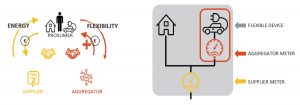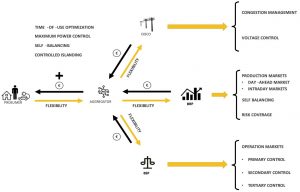In previous posts of this blog, we described the products, services and markets available today as well as those that are under development but which are guaranteed to be implemented through a stable, long-term regulatory framework. In this post we will develop how the flexibility provided by elements such as electric vehicles, heat pumps, storage systems, etc., can give added value to different agents in the electricity system and how to monetize this added value through different products or business models. It is necessary to emphasize that in a context in which the electricity sector is regulated by market mechanisms, in order to achieve a massive penetration of this type of resource and thus favor an overall increase in efficiency and the process of decarbonization, it is not enough for a solution to be viable from a technical point of view but it must also be viable from an economic point of view.

We will review what services a flexibility aggregator can provide to the different agents involved in the system. Some of these services are compatible with each other and therefore a flexibility aggregator could offer two or more compatible services simultaneously to more than one agent, thus maximizing the benefits derived from managing this flexibility. In other cases, the services or products offered will be incompatible and the aggregator will have to choose, depending on its portfolio of aggregated devices, which is its best business model and focus on specific products or services. It must be pointed out that the role of aggregator can be embedded within the retailer in some cases but in other cases, the aggregator and the retailer or supplier will be different companies. In the scheme represented in Fig. 1 we can observe how the supplier is in charge of providing energy to the prosumer but it is the aggregator the one managing its flexibility.

Fig. 1 Scheme representing aggregator and supplier as different companies. In some cases, both roles could be within the same company
In some cases, duplicate or redundant metering is needed for these kinds of applications. In the following paragraphs, the products that the aggregator can offer to the different agents of the system will be classified according to which agent within the electricity system can be a customer of them and the added value of each specific product will be explained for each specific customer. A summary of the different products as well as a representation of the interaction of the aggregator with the different agents can be observed in Fig. 2.
Specific products for distributors
The extent to which energy distribution companies can control what is happening in their networks is acceptable at a high voltage level but really low or non-existent in many cases in low voltage networks. In some circumstances, the power transformer stations that connect the low voltage network with the medium voltage network have tap changers that allow them to regulate the output voltage of the transformer to a certain degree depending on the load on the low voltage lines they serve. However, the number of operations that this type of device can perform is very limited since in the majority of the cases, they need to be done manually and once a tap is changed, it remains in that position for a long period of time, so this mechanism is not acceptable in a context where the dynamics of load variation causes rapid fluctuations in the voltage level. Something similar could be said about the use of capacitor banks that inject reactive power into the system raising its voltage. On one hand its use is not very extended and its control mechanisms do not allow a fast and continuous regulation of the injected reactive power.

Fig. 2 Scheme representing the aggregator interaction with the rest of the agents in the systems as well as the products the it can provide them.
Another issue to take into account is the possible overloading of lines and power transformer. It must be taken into account that the European low voltage distribution network in urban environments has a very complex topology which allows to be reconfigured, thus distributing the load from some power transformer stations to others, i.e. a certain line can be fed (not simultaneously) from two or more power transformer stations, thus allowing some congestion to be resolved. However, once again, in the majority of cases, this reconfiguration is manual and once it is done it tends to remain static for months or years, so this technique does not respond to the dynamic control requirements necessary to manage distributed resources with high variability either.
In this respect, it must be said that distributed resources not only provide flexibility in the sense that they can vary their power or shift their consumption over time, but a common feature is that they are connected to the grid through converters whose catalogue of functions is very extensive. Both electric vehicles with simple or bidirectional charge, as well as heat pumps, accumulation systems, photovoltaic systems and other resources are connected to the network through converters that allow a very fast variation of the working conditions. Regulations such as the one proposed by the IEEE in its 1547 Standard on the requirements for converters for interconnecting distributed resources to the network [1], or the advances made by working group WG17 of IEC’s technical committee TC57 to adapt the IEC 61850 standard on systems for the automation of power utilities already include this type of functionality for smart converters [2]. A detailed description of the above-mentioned functionalities goes beyond the scope of this document and can be found in the literature in documents such as the one proposed by the (Electric Power Research Institute) EPRI in its report on “Common Functions for Smart Inverters” [3]. In summary, we could say that the functionalities described are the enabling technologies for the implementation of the whole set of products and services that the flexible resources can offer to distributors and also to the rest of the system’s agents. In this way the products/services that a flexibility aggregator can offer to a distributor are the following:
- Congestion management: In the event that the aggregated resources are concentrated in a specific geographical distribution area, the aggregator could coordinate the resources in such a way as to guarantee a point of operation for the distributor below the overload. An example would be the coordinated charging of electric vehicles which would avoid peak loads and thus reduce the need for investments in network maintenance and upgrading by the distributor. Normally the peak demand in a low voltage network, depending on the consumer profile, can occur either at midday or at night. The distributor must have the necessary infrastructure to deal with these peaks of load, which normally last for a very short time, and this means operating for most of the time with an oversized infrastructure. The aggregation service would make it possible to resolve infrastructure congestion by coordinating flexibility and thus contribute to increasing the quality of supply, while also allowing distribution companies to save on infrastructure investment.
- Voltage control: As mentioned above, the voltage regulation mechanisms currently available to distributors are very few and have a slow dynamic at best. In this case, it should be mentioned that the distributed devices once again have an under-utilized asset which makes it possible to regulate the voltage, that is the converter present in solar generation systems, accumulation systems, in some electric vehicle recharging systems, etc. Grid connection converters use the rated current for very short periods of time, in the case of solar generators, for example, at most they will use that maximum current to inject active power at the hour of maximum radiation on a sunny day, the rest of the time they will be operating below their nominal capacity. In this case this capacity can be used to inject reactive power “free of charge” for the owner of the asset so that local voltage control is exercised in the distribution network. It should be noted that the example of the solar converter has been given because in case of a peak demand at night which causes large voltage drops, the full capacity of the solar converters could be used to inject reactive and raise the grid voltage. In addition, in the case of distribution networks, given the high R/X ratio (resistance/reactance), there is also a high correlation between consumption/injection of active power with the voltage level, so a Volt-Watt type control could also be implemented in the converters. This control would prevent excessive increase or decrease in voltage due to over-injection or overconsumption of distributed resources and in this case, this type of control could and should be installed in vehicle recharging systems, V2G systems, heat pumps, etc.
Specific products for balance responsible parties (BRPs)
BRPs are responsible for maintaining the energy balance in the system and are accountable for deviations from that balance. Because of this, it is common that a single BRP represents a diversified portfolio of generation technologies, as well as consumers or retailers, in order to reduce the risk of mismatches and therefore reduce costs. In this sense, having an aggregator within its portfolio of represented companies can give to the BRP a very important value due precisely to the flexibility that the aggregator manages. There are 3 mechanisms by which a BRP can monetize the flexibility services provided by an aggregator, which are the following:
- Day ahead portfolio optimization: The flexibility provided by the aggregator to the BRP will allow it to operate in the day ahead electricity market by transferring net-loading from periods of high market price to periods of low market price reducing its cost of energy purchase. In this way, the BRP could monetize in the daily market the flexibility provided by the aggregator which in turn should share these benefits with the managed prosumers.
- Intraday portfolio optimization: The model is similar to the one presented for the day-ahead market operation, but in this case the flexibility provided by the aggregator will be used by the BRP to operate in the different intraday markets.
- Self-balancing portfolio optimization: If any deviation from the schedule is detected in one of the so-called imbalance settlement periods (ISPs), the aggregator can provide the BRP with the necessary flexibility to reduce this imbalance and thus avoid penalties. The difference between this case and the two previous ones is that now the BRP will not use the aggregator’s flexibility to operate in the market but to reduce its deviation from its scheduled energy. However, as before, the BRP must remunerate the aggregator for this flexibility with an amount that must obviously be less than the penalty avoided. The aggregator must in turn remunerate the owners of the aggregated devices who are the ultimate suppliers of the flexibility. For example, an aggregator specialized in V2G applications could work with a BRP whose portfolio is based on renewable generation. In cases where the generation is lower than expected, the aggregator could send an order to the vehicles to inject power into the network during part of the ISP (usually 15 minutes), thus avoiding the deviation penalty. If the generation was higher than expected, the aggregator would give a charge order to the vehicles. In this way, remuneration could be obtained not only for injecting power into the network but also for consuming it in the appropriate period.
- Hedging/Portfolio adequacy: In this case the aggregator would sign a bilateral contract with a BRP in such a way that it would activate its flexibility at a fixed price in the event that the market price at which the BRP was purchasing the energy exceeded a certain value. As in the previous case, the service provided by the aggregator to the BRP would be remunerated according to the conditions set out in the contract and not through a market mechanism [4].
In the case of the three previous products, it must be taken into account that in some cases they may not be compatible with congestion management services provided to the distributor, i.e. the BRP may demand an increase in consumption from the aggregator but this increase in consumption is incompatible with avoiding congestion in a given distribution area. In these cases, there are mechanisms for prioritizing the power increase or decrease orders of an aggregator when it offers products simultaneously to BRPs and distributors [5].
Specific products for balance service providers (BSPs)
The services that an aggregator can provide to a BSP are very similar in technical terms to those provided to a BRP, the main difference is the way in which the BSP benefits from them. In this case the BSP can use the flexibility to participate in operation markets selling primary, secondary or tertiary regulation, so in this case the products offered are clear:
- Primary control: for this model, aggregator should configure the distributed resources it manages to respond very quickly and automatically to changes in network frequency. This does not pose any technical difficulty since the converters used to interface the distributed resource with the grid have PLL (Phase Locked Loop) systems that allow them to synchronize with the network and therefore estimate variations in frequency. In the case of electric vehicles, in the event of detecting a drop in the grid frequency, the charger could automatically cut off the charge and thus assist in restoring the frequency and supporting the system. If the vehicles were also equipped with V2G technology, they could also react to a drop in the frequency by injecting power. It should be borne in mind that the energy managed in the primary regulation is relatively small because its duration does not exceed a few seconds so the charging times of the vehicles in the example described would not be affected. In some countries such as Spain this service is compulsory but not paid. In other countries, such as Germany, this service is auctioned on a weekly basis.
- Secondary control: the activation signal for flexibility would be automatically generated in a central control system which would impose the activation of power increase or decrease by zones. In this case the power to be increased or decreased should also be maintained for short periods of time determined by the duration of the imbalance settlement periods (15 minutes) so that the activation of this service would not, in principle, entail a relevant loss of comfort for the end users in the vast majority of cases. In other words, the mere fact of delaying by 15 minutes the turning on or off of a heat pump or the charging of an electric vehicle would have practically no impact on the end user but it could bring important benefits for the system and also generate important economical revenues for the aggregator and the end users.
- Tertiary control: The business model of providing flexibility to participate in tertiary regulation is very similar to that described in for secondary regulation but in this case the response time is longer and the power to rise or fall must be maintained over time for a longer period. The aggregator could stagger short duration orders of power increase/decrease to the different devices that it manages, making the action last globally the two hours required but without causing losses of comfort to the end users.
As mentioned for services provided to BRPs, in the case of services provided to BSPs, there may be temporary in compatibilities with services provided to distributors in case the aggregator offers services simultaneously to both agents. However, there is no incompatibility between services provided by the aggregator to a BRP and to a BSP simultaneously.
Specific products for prosumers or active consumers
The prosumer is the key player and ultimate provider of the flexibility that will most commonly be managed through an aggregator or energy community. In the case of the energy community, it can assume the functions of the aggregator, manage the flexibility of its associates and reach agreements with both BRPs and BSPs to put value this flexibility. As energy communities are, by definition, non-profit making entities, the profits obtained would be used to reduce the price of the electricity supply of their associates. This price reduction should be applied in a manner proportional to the flexibility provided by each of the associates.
When an active consumer signs a supply contract with a retailer, the latter can act as an aggregator, managing not only the consumer supply but also its flexibility and permitting the consumer to participate in part of the profits obtained by using its flexibility in the various markets previously described. It may also be the case that the aggregator and the retailer are presented as separate entities so that the retailer is responsible for supplying the energy to the prosumer but it is the aggregator that manages its flexibility and operates with it by offering it to distributors, BRPs and BSPs, in which case the prosumer should also participate in part of the profits obtained by the aggregator. To illustrate, a given active consumer could contract his supply with retailer “A” but the management of the charge/discharge of his EV in the case of V2G would be assigned to an aggregator “B”. Company A would install a meter covering the whole installation (House plus vehicle) to bill for the energy consumed. Company B would install a meter that would only affect the EV charger in order to know how much flexible energy has been used. The consumer would pay for the energy used to charge the car to A, but B would pay the consumer for manage the process of charge/discharge the vehicle. The possibilities here are endless.
The previous paragraph has described how to involve prosumers in the benefits that aggregators can obtain from managing the flexibility provided by consumers.
However, there are products that aggregators can offer directly and specifically to consumers so that they benefit directly from their own flexibility. These services are as follows [4; 5]:
- Time-of-Use optimization: The tariffs that retailers offer to their customers have, in some occasions, variable prices in the different periods of the day and in some cases, these prices may even vary dynamically in real time. The aggregator can understand the customer’s capabilities and habits to shift as much as load as possible from high to low price periods and thus make the consumer get the most benefit of its flexibility by reducing its energy cost.
- Maximum Power control: A very important term in the majority of electricity tariffs offered by retailers is the so-called power term which represents the cost of the availability of In other words, the user will pay more the higher the peak power it can consume. In many cases, the power term represents a very important part of the tariff and the user only reaches this power in specific situations, i.e. charging the vehicle to coincide with a consumption peak in the home. Let us assume that a user has a photovoltaic generator, an accumulation system and an electric vehicle. Let us also suppose that the surplus energy generated by the PV panel during the day is used to charge the battery and the battery begins to discharge at 7 pm because the electricity consumption of the home begins to increase. At 10 pm, the electric vehicle starts to charge but the battery is already discharged so that all the power of the vehicle plus that of the house has to be obtained from the network, which means a high peak and implies the need to increase the power term of the tariff and with it the total cost. The aggregator would charge the battery during the day but would not start discharging it at 7 pm but would wait until the vehicle demanded power at 10 pm and would discharge the battery against the vehicle, in this way the impact of the vehicle would be less and the user could reduce the power term of the tariff. This is just one of countless examples that can be given.
- Self-balancing: Similar to the previous product and available to those prosumers who have significant flexible capacity, self-balancing techniques would allow all the prosumer’s flexible resources to be managed in an integrated and optimal way, taking into account energy purchase and sales prices, capacities and consumer habits.
- Controlled islanding: In the case of weak networks with power quality problems such as micro-outages or undervoltage or overvoltage problems, the aggregator could intentionally isolate the consumer from the network and make it self-sufficient for a certain period of time.
[1] “IEEE Draft Standard Conformance Test Procedures for Equipment Interconnecting Distributed Energy Resources with Electric Power Systems and Associated Interfaces,” IEEE P1547.1/D9.8, December 2019, pp. 1–283, 2019.
[2] T. C. 57 IEC, “IEC 61850: Communication networks and systems for power utility automation,” International Electrotechnical Commission Std, vol. 53, p. 54, 2010.
[3] Common Functions for Smart Inverters: 4th Edition, EPRI, Palo Alto, CA, 2016, 3002008217.
[4] H. de Heer and M. van der Laan, “USEF: Workstream on Aggregator Implementation Models,” USEF Aggregator Workstream Final Report, 2017.
[5] P. Olivella-Rosell, P. Lloret-Gallego, Munné-Collado, R. Villafafila-Robles, A. Sumper, S. Ottessen, J. Rajasekharan, and B. Bremdal, “Local Flexibility Market Design for Aggregators Providing Multiple Flexibility Services at Distribution Network Level,” Energies, vol. 11, p. 882, 2018.

